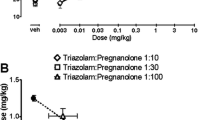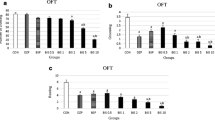Abstract
The behavioral effects of a wide range of BZ (ω) receptor ligands, including non-selective full (alprazolam, clorazepate, chlordiazepoxide and diazepam) and partial (bretazenil, imidazenil and Ro 19-8022) agonists, and selective BZ-1 (ω 1) (abecarnil, CL 218,872, CL 284,846 and zolpidem) receptor ligands, were compared in the rat elevated plus-maze test. Behaviors recorded comprised the traditional indices of anxiety as well as a number of ethologically derived measures. In addition, the specificity of drug effects was evaluated by measuring spontaneous locomotor activity in activity cages in separate groups of animals. Results showed that all compounds tested not only increased the proportion of time spent and proportion of entries into the open arms of the maze (considered as traditional indices of anxiety) but also affected headdippings and attempts at entry into open arms, which can be considered as indices of risk assessment responses. However, the magnitude of these effects was generally smaller with the BZ-1 (ω 1) selective agents. Moreover, additional differences were apparent on the total number of arm entries measure, which was significantly increased by most full and all partial agonists, but was unaffected by the selective BZ-1 (ω 1) compounds. If it is assumed that total arm entries are contaminated by anxiety, the latter finding indicates a weaker anxiety-reducing potential of selective BZ-1 (ω 1) ligands. Importantly, the increase in total arm entries induced by the non-selective agents was not associated with a similar effect on locomotion as revealed in the actimeter. Finally, anxiolysis produced by the BZ-1 (ω 1) ligands was invariably observed at doses which reduced locomotor activity, suggesting that the anxiolytic-like effects of these compounds are confounded by decreases in locomotor activity.
Similar content being viewed by others
References
Auta J, Romeo E, Kozikowski A, Ma D, Costa E, Guidotti A (1993) Participation of mitochondrial diazepam binding inhibitor receptors in the anticonflict, antineophobic and anticonvulsant action of 2-aryl-3-indoleacetaminde and imidazopyridine derivatives. J Pharmacol Exp Ther 265:649–656
Belzung C, Misslin R, Vogel E (1989) Behavioural effects of the benzodiazepine receptor partial agonist RO 16-6028 in mice. Psychopharmacology 97:388–391
Blanchard DC, Blanchard RJ, Tom P, Rodgers RJ (1990a) Diazepam changes risk assessment in an anxiety/defense test battery. Psychopharmacology 101:511–518
Blanchard DC, Rodgers RJ, Blanchard RJ (1990b) Ethopharmacological control of fear and anxiety in the rat. In: Brain PF, Parmigiani F, Blanchard RJ, Mainardi D (eds) Fear and defence. Harwood Academic Publishers, London, pp 245–267
Cole JC, Rodgers RJ (1993) An ethological analysis of the effects of chlordiazepoxide and bretazenil (Ro 16-6028) in the murine elevated plus-maze. Behav Pharmacol 4:573–580
Cole JC, Rodgers RJ (1994) Ethological evaluation of the effects of acute and chronic buspirone treatment in the murine elevated plus-maze test: comparison with haloperidol. Psychopharmacology 114:288–296
Cruz APM, Frei F, Graeff FG (1994) Ethopharmacological analysis of rat behavior on the elevated plus-maze. Pharmacol Biochem Behav 49:171–176
Davies MF, Onaivi ES, Chen S-W, Maguire PA, Tsai NF, Loew GH (1994) Evidence for central benzodiazepine receptor heterogeneity from behavior tests. Pharmacol Biochem Behav 49:47–56
Dawson GR, Crawford SP, Collinson N, Iversen SD, Tricklebank MD (1995) Evidence that the anxiolytic-like effects of chlordiazepoxide on the elevated plus maze are confounded by increases in locomotor activity. Psychopharmacology 118:316–323
Day IP, Clody DE, Monaghan MM, Abel MS, Dusza JP, Beer B (1992) Pharmacology of CL 284,846, a non-benzodiazepine sedative with reduced amnestic liability. Soc Neurosci Abstr 18:725
Dazzi L, Motzo C, Imperato A, Serra M, Gessa GL, Biggio G (1995) Modulation of basal and stress-induced release of acetylcholine and dopamine in rat brain by abecarnil and imidazenil, two anxioselectiveγ-aminobutyric acidA receptor modulators. J Pharmacol Exp Ther 273:241–247
Depoortere H, Zivkovic B, Lloyd KG, Sanger DJ, Perrault G, Langer SZ, Bartholini G (1986) Zolpidem, a novel non-benzodiazepine hypnotic: I. Neuropharmacological and behavioral effects. J Pharmacol Exp Ther 237:649–658
Faure-Halley C, Graham D, Arbilla S, Langer SZ (1993) Expression and properties of recombinantα 1 β 2 γ 2 andα 5 β 2 γ 2 forms of the rat GABAA receptor. Eur J Pharmacol 246:283–287
File SE (1992) Behavioural detection of anxiolytic action. In: Elliott JM, Heal DJ, Marsden CA (eds) Experimental approaches to anxiety and depression. John Wiley, Chichester, pp 25–44
Giusti P, Ducic I, Puia G, Arban R, Walser A, Guidotti A, Costa E (1993) Imidazenil: a new partial positive allosteric modulator ofγ-aminobutyric acid (GABA) action at GABAA receptors. J Pharmacol Exp Ther 266:1018–1028
Griebel G, Belzung C, Misslin R, Vogel E (1993) The free-exploratory paradigm: an effective method for measuring neophobic behaviour in mice and testing potential neophobia-reducing drugs. Behav Pharmacol 4:637–644
Griebel G, Moreau J-L, Jenck F, Misslin R, Martin JR (1994) Acute and chronic treatment with 5-HT reuptake inhibitors differentially modulate emotional responses in anxiety models in rodents. Psychopharmacology 113:463–470
Griebel G, Blanchard DC, Jung A, Blanchard RJ (1995) A model of “antipredator” defense in Swiss-Webster mice: effects of benzodiazepine receptor ligands with different intrinsic activities. Behav Pharmacol 7:732–745
Haefely W, Martin JR, Schoch P (1990) Novel anxiolytics that acts as partial agonists at benzodiazepine receptors. Trends Pharmacol Sci 11:452–456
Handley SL, McBlane JW (1993) An assessment of the elevated X-maze for studying anxiety and anxiety-modulating drugs. J Pharmacol Toxicol Methods 29:129–138
Jenck F, Moreau JL, Bonetti EP, Martin JR, Haefely WE (1992) Ro 19-8022, a nonbenzodiazepine partial agonist at benzodiazepine receptors: neuropharmacological profile of a potential anxiolytic. J Pharmacol Exp Ther 262:1121–1127
Jones GH, Schneider C, Schneider HH, Seidler J, Cole BJ, Stephens DN (1994) Comparison of several benzodiazepine receptor ligands in two models of anxiolytic activity in the mouse: an analysis based on fractional receptor occupancies. Psychopharmacology 114:191–199
Knoflach F, Drechsler U, Scheurer L, Malherbe P, Mohler H (1993) Full and partial agonism displayed by benzodiazepine receptor ligands at recombinantγ-aminobutyric acidA receptor. J Pharmacol Exp Ther 266:385–391
Lader M (1994) Benzodiazepines: a risk-benefit profile. CNS Drugs 1:377–387
Langer SZ, Arbilla S (1988) Imidazopyridines as a tool for the characterization of benzodiazepine receptors: a proposal for a pharmacological classification asω receptor subtypes. Pharmacol Biochem Behav 29:763–766
Lippa AS, Coupet J, Greenblatt EN, Klepner CA, Beer B (1979) A synthetic non-benzodiazepine ligand for benzodiazepine receptors: a probe for investigating neuronal substrates of anxiety. Pharmacol Biochem Behav 11:99–106
Lister RG (1987) The use of a plus-maze to measure anxiety in the mouse. Psychopharmacology 92:180–185
Martin JR, Pieri L, Bonetti EP, Schaffner R, Burkard WP, Cumin R, Haefely WE (1988) Ro 16-6028: a novel anxiolytic acting as a partial agonist at the benzodiazepine receptor. Pharmacopsychiatry 21:360–362
Martin JR, Schoch P, Jenck F, Moreau J-L, Haefely WE (1993) Pharmacological characterization of benzodiazepine receptor ligands with intrinsic efficacies ranging from high to zero. Psychopharmacology 111:415–422
Ozawa M, Nakada Y, Sugimachi K, Yabuuchi F, Akai T, Mizuta E, Kuno S, Yamaguchi M (1994) Pharmacological characterization of the novel anxiolyticβ-carboline abecarnil in rodents and primates. Jpn J Pharmacol 64:179–187
Pellow S, File SE (1986) Anxiolytic and anxiogenic drug effects on exploratory activity in an elevated plus-maze: a novel test of anxiety in the rat. Pharmacol Biochem Behav 24:525–529
Pellow S, Chopin P, File SE, Briley M (1985) Validation of open: closed arm entries in an elevated plus-maze as a measure of anxiety in the rat. J Neurosci Methods 14:149–167
Potokar J, Nutt DJ (1994) Anxiolytic potential of benzodiazepine receptor partial agonists. CNS Drugs 1:305–315
Pritchett DB, Seeburg PH (1990)γ-Aminobutyric acidA receptorα 5-subunit creates novel type II benzodiazepine receptor pharmacology. J Neurochem 54:1802–1804
Pritchett DB, Lüddens H, Seeburg PH (1989) Type I and type II GABAA-benzodiazepine receptors produced in transfected cells. Science 245:1389–1392
Puia G, Ducic I, Vicini S, Costa E (1992) Molecular mechanisms of the partial allosteric modulatory effects of bretazenil atγ-aminobutyric acid type A receptor. Proc Natl Acad Sci USA 89:3620–3624
Rodgers RJ, Cole JC (1993) Anxiety enhancement in the murine elevated plus maze by immediate prior exposure to social stressors. Physiol Behav 53:383–388
Rodgers RJ, Cole JC, Cobain MR, Daly P (1992a) Anxiogenic-like effects of fluprazine and eltoprazine in the mouse elevated plus-maze: profile comparisons with 8-OH-DPAT, CGS 12066B, TFMPP and mCPP. Behav Pharmacol 3:621–634
Rodgers RJ, Lee C, Shepherd JK (1992b) Effects of diazepam on behavioural and antinociceptive responses to the elevated plus-maze in male mice depend upon treatment regimen and prior maze experience. Psychopharmacology 106:102–110
Sanger DJ (1995) The behavioural effects of novel benzodiazepine (ω) receptor agonists and partial agonists: increases in punished responding and antagonism of the pentylenetetrazole cue. Behav Pharmacol 6:116–126
Sanger DJ, Perrault G, Morel E, Joly D, Zivkovic B (1991) Animal models of anxiety and the development of novel anxiolytic drugs. Prog Neuropsychopharmacol Biol Psychiatry 15:205–212
Sanger DJ, Benavides J, Perrault G, Morel E, Cohen C, Joly D, Zivkovic B (1994) Recent developments in the behavioral pharmacology of benzodiazepine (ω) receptors: evidence for the functional significance of receptor subtypes. Neurosci Biobehav Rev 18:355–372
Sieghart W (1995) Structure and pharmacology ofγ-aminobutyric acidA receptor subtypes. Pharmacol Rev 47:181–234
Sieghart W, Schuster A (1984) Affinity of various ligands for benzodiazepine receptors in rat cerebellum and hippocampus. Biochem Pharmacol 33:4033–4038
Squires RF, Benson DI, Braestrup C, Coupet J, Klepner CA, Myers V, Beer B (1979) Some properties of brain specific benzodiazepine receptors: new evidence for multiple receptors. Pharmacol Biochem Behav 10:825–830
Stephens DN, Voet B (1994) Differential effects of anxiolytic and non-anxiolytic benzodiazepine receptor ligands on performance of a differential reinforcement of low rate (DRL) schedule. Behav Pharmacol 5:4–14
Stephens DN, Schneider HH, Kehr W, Andrews JS, Rettig KJ, Turski L, Schmiechen R, Turner JD, Jensen LH, Petersen EN et al. (1990) Abecarnil, a metabolically stable, anxioselectiveβ-carboline acting at benzodiazepine receptors. J Pharmacol Exp Ther 253:334–343
Treit D (1985) Animal models for the study of anti-anxiety agents: a review. Neurosci Biobehav Rev 9:203–222
Treit D, Menard J, Royan C (1993) Anxiogenic stimuli in the elevated plus-maze. Pharmacol Biochem Behav 44:463–469
Wafford KA, Whiting PJ, Kemp JA (1993) Differences in affinity and efficacy of benzodiazepine receptor ligands at recombinantγ-aminobutyric acid receptor subtypes. Mol Pharmacol 43:240–244
Zivkovic B, Morel E, Joly D, Perrault G, Sanger DJ, Lloyd KG (1990) Pharmacological and behavioral profile of alpidem as an anxiolytic. Pharmacopsychiatry 23 [Suppl 3]:108–113
Zivkovic B, Perrault G, Sanger D (1992) Receptor subtype-selective drugs: a new generation of anxiolytics and hypnotics. In: Mendlewitz J, Racagni G (eds) Target receptors for anxiolytics and hypnotics: from molecular pharmacology to therapeutics. Karger, Basel, pp 55–73
Author information
Authors and Affiliations
Rights and permissions
About this article
Cite this article
Griebel, G., Sanger, D.J. & Perrault, G. The use of the rat elevated plus-maze to discriminate between non-selective and BZ-1 (ω 1) selective, benzodiazepine receptor ligands. Psychopharmacology 124, 245–254 (1996). https://doi.org/10.1007/BF02246664
Received:
Revised:
Issue Date:
DOI: https://doi.org/10.1007/BF02246664




